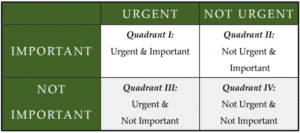6 Reasons Planning Is a Pain (and Why You Should Do It Anyway)
 Smart, capable people often struggle with one crucial aspect of knowledge work: planning. In my experience, clients resist planning for a number of reasons. Here are some of the most common.
Smart, capable people often struggle with one crucial aspect of knowledge work: planning. In my experience, clients resist planning for a number of reasons. Here are some of the most common.
Planning causes mental pain, at least at first. Planning is taxing work. If you haven’t done it recently or it’s not a habit, it will literally cause pain when you do it. My university students helped me define this pain; it is the feeling of frustration. “It’s too hard.” “I’m just not good at this.” So, we give up too easily, avoiding the frustration of learning how to plan and developing the habit of planning.
Planning takes time. On average, your weekly planning will take 45 minutes or so. That’s for a routine week. If your upcoming week is challenging, planning may take twice that long. Daily planning will take 10-15 minutes. As with many activities, it feels easier to just jump in and start work. Doing so makes us feel that we are, at least, making progress. So we skip planning and just get started.
Planning is deep work. Some people think that planning is merely running over their to-do list. But real planning is the difficult exercise of estimating how long tasks will take and a thoughtful look at our tasks versus our constraints. It forces us to clearly define our commitments and deliverables. Most of us prefer to avoid this deep work, so we substitute a shallow, watered down version. We leave our commitments murky and don’t clarify through planning.
Planning forces us to say “No”. We don’t like to say no to others. Good planning shows conflicting commitments and when our capacity is full. Thus, planning forces us to make choices that likely result in difficult conversations. This brings us face to face with our priorities, which may not be clear. It is much easier, in the short run, to play hero and worry about the consequences later, so we don’t plan.
Planning shows hard truths. When you plan, you realize your limitations and understand your constraints. This is much more challenging than just believing everything will work out. Over time, planning also shows you how long it actually takes to get your tasks accomplished. This can challenge your mental image of how good you are at some of your tasks. These challenges are uncomfortable; we avoid planning so we don’t have to face them.
Planning is inexact. Even the most experienced planners and project managers cannot predict the future. Things happen. Key resources take a sick day. A supplier’s truck breaks down. In addition, we are predictably bad estimators, typically underestimating both the time it takes to do something and how much discretionary time we will have in a given day or week. Our plans don’t work out, so we abandon planning.
So, we resist planning because it is painful, time-consuming deep work, that doesn’t work perfectly and forces us to confront an uncomfortable reality. But I would like to show two essential parameters that planning produces: The first is time boxes that show us how much time we can allocate to any given task. The second is milestones, which show where we should be on a multi-step project. Clarity on these two parameters is our responsibility in managing our schedule and tasks.
Time boxes force us to deliver even when the level of quality is unclear. We can be perfectionists and let deadlines slip chasing perfection. Remember that the quality of knowledge work is notoriously difficult to define. Challenge yourself to work hard for the duration, but, when the time is up, ship the result. It is probably at least good enough. Time boxes help give us the courage to “just ship it” on the deadline.
But, even if it is not good enough, you probably don’t know how to fix it. My experience as a writer shows this challenge. I invariably think part X is bad while part Y is good. However, my reviewers and editors think the opposite. So, rather than continuing to perfect part X, I should have been working on part Y. The same holds true for much of our work: presentations, reports, and communication. The parts we think need additional work are actually OK, but we overlook parts that need shoring up. So, instead of exceeding our time boxes and blowing our schedule by chasing our view of perfection, we should set shorter time boxes and use the additional time to get feedback on what needs attention.
In addition, using time boxes gives good historical data on how long a task actually takes. Working on a deliverable in short spurts is inefficient and makes it difficult to tell how much work we actually did. We need to know how long the task took last time in order to guess better how long it will take this time. Disciplined work during time boxes shows us that.
Milestones are advance warning signs that a project may not turn out well. Milestones give us time to renegotiate our commitments while our stakeholders still have time to adjust. In my experience as a project manager, people are usually reasonable when they know of a problem in advance. They are less reasonable when they find out today that we don’t have something they expected to get yesterday. Some of our work is speculative; we guess, in advance, how long a task will take. Sometimes those guesses are wrong. Maybe our stakeholders can do without a piece of the work. Maybe we misunderstood their deadline. Maybe they’re happier with a blue one on time than a green one that is late. But, we only find out by having the conversation. Milestones help us do that earlier.
Planning is challenging and can be painful. But, good planning produces time boxes and milestones. These parameters help us face reality, rather than living in an imaginary, but happy, world of false bravado and superheros who can overcome any constraint. They parameters help us keep our time under control and give us the best chance to make our stakeholders happy. Planning is imperfect, but, when it comes to executing our work, an imperfect view of reality beats a 20/20 view of a fantasy every time. So, overcome the pain and challenges and plan your work.
